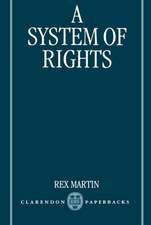Measuring Trends in U.S. Income Inequality: Theory and Applications: Lecture Notes in Economics and Mathematical Systems, cartea 459
Autor Hang K. Ryu, Daniel J. Slottjeen Limba Engleză Paperback – 20 mai 1998
Din seria Lecture Notes in Economics and Mathematical Systems
-
 Preț: 360.02 lei
Preț: 360.02 lei -
 Preț: 383.93 lei
Preț: 383.93 lei - 15%
 Preț: 693.39 lei
Preț: 693.39 lei -
 Preț: 384.09 lei
Preț: 384.09 lei -
 Preț: 380.07 lei
Preț: 380.07 lei -
 Preț: 446.26 lei
Preț: 446.26 lei -
 Preț: 497.37 lei
Preț: 497.37 lei -
 Preț: 380.84 lei
Preț: 380.84 lei -
 Preț: 384.86 lei
Preț: 384.86 lei -
 Preț: 378.34 lei
Preț: 378.34 lei -
 Preț: 399.67 lei
Preț: 399.67 lei - 20%
 Preț: 360.93 lei
Preț: 360.93 lei - 15%
 Preț: 643.16 lei
Preț: 643.16 lei -
 Preț: 379.09 lei
Preț: 379.09 lei -
 Preț: 404.76 lei
Preț: 404.76 lei -
 Preț: 385.62 lei
Preț: 385.62 lei - 15%
 Preț: 644.49 lei
Preț: 644.49 lei -
 Preț: 379.09 lei
Preț: 379.09 lei -
 Preț: 345.50 lei
Preț: 345.50 lei -
 Preț: 425.80 lei
Preț: 425.80 lei -
 Preț: 378.34 lei
Preț: 378.34 lei - 18%
 Preț: 775.65 lei
Preț: 775.65 lei -
 Preț: 392.60 lei
Preț: 392.60 lei -
 Preț: 401.61 lei
Preț: 401.61 lei - 15%
 Preț: 646.43 lei
Preț: 646.43 lei -
 Preț: 382.18 lei
Preț: 382.18 lei -
 Preț: 378.34 lei
Preț: 378.34 lei - 15%
 Preț: 637.59 lei
Preț: 637.59 lei - 15%
 Preț: 647.27 lei
Preț: 647.27 lei -
 Preț: 377.73 lei
Preț: 377.73 lei -
 Preț: 447.84 lei
Preț: 447.84 lei - 15%
 Preț: 644.49 lei
Preț: 644.49 lei -
 Preț: 386.00 lei
Preț: 386.00 lei - 15%
 Preț: 654.43 lei
Preț: 654.43 lei -
 Preț: 415.02 lei
Preț: 415.02 lei -
 Preț: 411.54 lei
Preț: 411.54 lei -
 Preț: 398.92 lei
Preț: 398.92 lei -
 Preț: 398.92 lei
Preț: 398.92 lei -
 Preț: 392.75 lei
Preț: 392.75 lei - 15%
 Preț: 635.47 lei
Preț: 635.47 lei - 20%
 Preț: 653.56 lei
Preț: 653.56 lei -
 Preț: 379.86 lei
Preț: 379.86 lei -
 Preț: 495.46 lei
Preț: 495.46 lei -
 Preț: 447.99 lei
Preț: 447.99 lei -
 Preț: 378.71 lei
Preț: 378.71 lei - 15%
 Preț: 637.13 lei
Preț: 637.13 lei -
 Preț: 385.84 lei
Preț: 385.84 lei -
 Preț: 378.54 lei
Preț: 378.54 lei - 15%
 Preț: 666.55 lei
Preț: 666.55 lei
Preț: 383.33 lei
Nou
Puncte Express: 575
Preț estimativ în valută:
73.35€ • 78.44$ • 61.16£
73.35€ • 78.44$ • 61.16£
Carte tipărită la comandă
Livrare economică 17 aprilie-01 mai
Preluare comenzi: 021 569.72.76
Specificații
ISBN-13: 9783540642299
ISBN-10: 3540642293
Pagini: 208
Ilustrații: XII, 196 p.
Dimensiuni: 155 x 235 x 11 mm
Greutate: 0.3 kg
Ediția:1998
Editura: Springer Berlin, Heidelberg
Colecția Springer
Seria Lecture Notes in Economics and Mathematical Systems
Locul publicării:Berlin, Heidelberg, Germany
ISBN-10: 3540642293
Pagini: 208
Ilustrații: XII, 196 p.
Dimensiuni: 155 x 235 x 11 mm
Greutate: 0.3 kg
Ediția:1998
Editura: Springer Berlin, Heidelberg
Colecția Springer
Seria Lecture Notes in Economics and Mathematical Systems
Locul publicării:Berlin, Heidelberg, Germany
Public țintă
ResearchCuprins
1 Introduction.- 1.1 Introduction.- 1.2 A Brief Review of the Literature.- 1.3 An Overview of Recent Trends in Income Inequality in the U.S..- 1.4 The Plan of the Book.- 2 The Maximum Entropy Estimation Method.- 2.1 Review of Jaynes’ (1979) Concentration Theorem.- 2.2 Determination of a Maximum Entropy Density Function Given Known Moments.- 2.3 Estimation of the Maximum Entropy (ME) Density Function When Moments are Unknown.- 2.4 Estimation of the Exponential Density Function for N>2.- 2.5 Asymptotic Properties of the Maximum Entropy Density function.- 2.6 Maximum Entropy Estimation of Univariate Regression Functions.- 2.7 Model Selection for Maximum Entropy Regression.- 3 Capabilities and Earnings Inequality.- 3.1 Introduction.- 3.2 The Theory.- 3.3 Empirical Results.- 3.4 Summary and Concluding Remarks.- Appendix 3.A: Derivation of an Earnings Distribution With Maximum Entropy Method.- 4 Some New Functional Forms for Approximating Lorenz Curves.- 4.1 Introduction.- 4.2 A Flexible Lorenz Curve with Exponential Polynomials.- 4.3 Approximation of the Empirical Lorenz Curve.- 4.4 A Comparison of Two Alternative Derivations of the Lorenz Curves.- 4.5 Choosing an Exponential Series Expansion Rather Than a Plain Series Expansion.- 4.6 About Expanding the Inverse Distribution Rather Than a Lorenz Curve in a Series.- 4.7 Orthonormal Basis Expansion for Discrete Ordered Income Observations.- 4.8 A Flexible Lorenz Curve with Bernstein Polynomials.- 4.9 Applications with Actual Data.- 4.10 Summary and Concluding Remarks.- 5 Comparing Income Distributions Using Index Space Representations.- 5.1 Introduction.- 5.2 The Theory.- 5.3 Theil’s Entropy Measure.- 5.4 Maximum Entropy Estimation of Share Functions.- 5.5 Motivation for Decomposing the Share Function Through the LegendreFunctions.- 5.6 A Comparison of Index Space Analysis to Spectral Analysis.- 5.7 Empirical Results.- 5.8 Summary and Concluding Remarks.- Appendix 5.A: A Review of the Concepts of Completeness, Orthonormality, and Basis.- 6 Coordinate Space vs. Index Space Representations as Estimation Methods: An Application to How Macro Activity Affects the U.S. Income Distribution.- 6.1 Introduction.- 6.2 The Theory.- 6.3 An Index Space Representation of the Share function.- 6.4 A Comparison of the Index Space Representation with the Coordinate Space Representation.- 6.5 The Impact of Macroeconomic Variables on the Share function.- 6.6 Inequality Measures Associated with the Legendre Polynomial Expanded Share function.- 6.7 The Empirical Results.- 6.8 Summary and Concluding Remarks.- 7 A New Method for Estimating limited Dependent Variables: An Analysis of Hunger.- 7.1 Introduction.- 7.2 Model Specification.- 7.3 Posterior Odds Ratios to Compare Alternative Regression Hypotheses.- 7.4 The Empirical Results.- 7.5 Summary and Concluding Remarks.- Author Index.
















